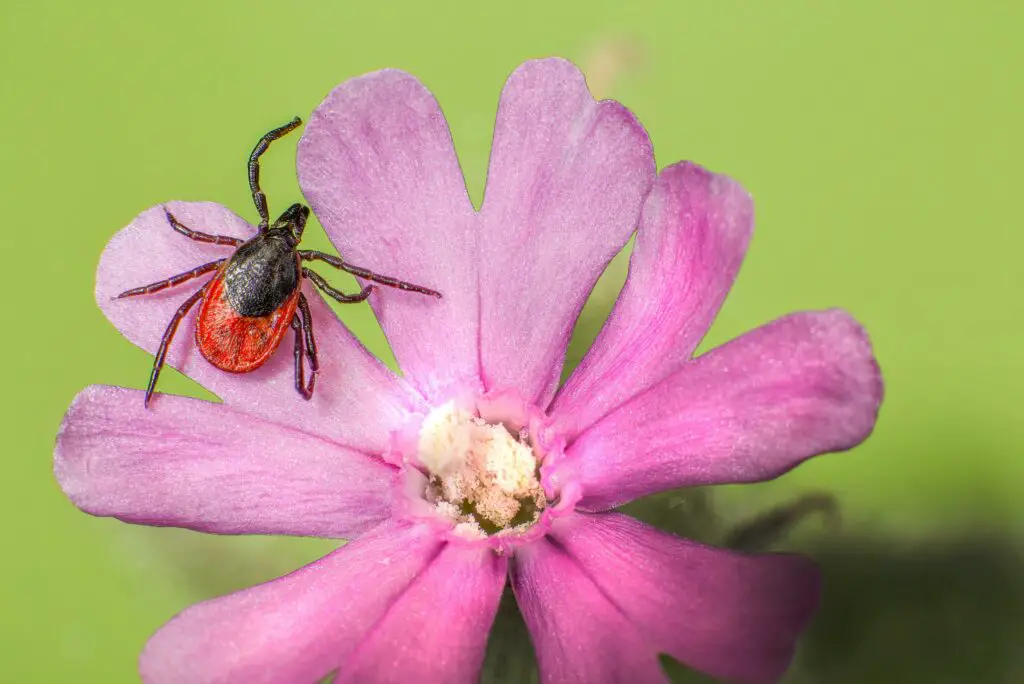Nature is the home to an incredibly versatile array of species, but ticks are definitely one of those that we tend to avoid at all costs.
These tiny arachnids, that are related to spiders, mites, and scorpions, are in fact parasites that survive by attaching themselves to larger animals and feeding on their blood. Humans aren’t spared either. Sadly, these insects carry harmful bacteria that can spread disease to people.
Sadly, tick-borne diseases are at an all-time high, with about 50,000 cases reported each year, and far more going unreported.

There are different types of ticks, and unfortunately, they sometimes find their way to people’s homes. The types most commonly found in homes are the black-legged tick, the dog tick, and the brown dog tick.
- Black-legged Ticks – known as deer ticks, these ticks are typically brown or black in color and have a flattened, oval-shaped body. They are commonly found in wooded areas and can transmit Lyme disease.
- Dog Ticks are larger and can range in color from brown to reddish-brown. They have a tough, shield-shaped body. Dog ticks can transmit diseases such as Rocky Mountain spotted fever.
- Brown Dog Ticks are brown in color and have a slender body.
Although the tick season is between March and October, or sometimes longer, we should be wary of this insects all year round. In fact,if beaten by a tick, a person can develop symptoms even after two or three months.

The bite itself isn’t painful and can cause swelling, itchiness, blistering, and bruising. The bad thing is that ticks also carry and transmit severe diseases, most commonly Lyme disease, as well as Rocky Mountain spotted fever, ehrlichiosis, and babesiosis.
Initially, Lyme disease develops as a circular red ‘bull’s eye’ rash around the site of a tick bite. However, not everyone gets a rash and you should also watch out for a flu-like illness with fever, headache, tiredness and general aches and pains.
The best way to prevent being bitten by a tick is to avoid tall grasses and areas where ticks thrive (such as moorlands and woodlands), especially during the warmer months.
In case you do get bitten, you should remove the tick as soon as possible in order to prevent infections.

These are some of the ways of safe removal.
- Use fine-tipped tweezers: Use clean, fine-tipped tweezers to grasp the tick as close to the skin as possible.
- Pull gently: Apply steady upward pressure, being careful not to squeeze or crush the tick. Aim to remove the tick in one smooth motion without twisting or jerking. Twisting or jerking can cause the tick’s head to break off and stay inside the skin, where it can still transmit disease.
- Clean the area: After removing the tick, clean the affected area with soap and water or an antiseptic solution. Monitor the site of the bite for any signs of infection or a rash, and consult a healthcare professional if necessary.

If by any chance ticks find their way into your home, take immediate action in order to prevent infestation. Most times, ticks are brought into your home in case they stick on your clothes or onto your pets.
- Isolate the area: If you have identified the presence of ticks in a specific area, keep pets and children away from that space.
- Wear protective gear: Put on gloves and a long-sleeved shirt to protect yourself from potential tick bites.
- Clean the area: Clean the area where you found the tick. If it is in bedding, wash the sheets. Inspect the area to ensure there are no more ticks that are present. Dispose of the tick by either flushing it down the toilet or sealing it in a container or ziplock bag before placing it in the trash.
mãe – o motivo me preocupou muito, então confrontei minha esposa

Sam costumava ser um menino da mamãe, sempre agarrado a Candice e se iluminando ao vê-la. Mas um dia, isso mudou. Ele começou a evitar seus abraços, seus beijos e até mesmo sua presença. No começo, pensei que era apenas uma fase. Mas havia mais. Muito mais.
O que poderia fazer um garoto de cinco anos se afastar repentinamente da pessoa que ele mais adorava? Sua confissão não só me chocou, mas também me levou a descobrir um segredo de família que Candice estava escondendo.
Um segredo que a deixou em lágrimas por semanas.

Uma mulher chorando | Fonte: Pexels
Meu nome é Robert. Tenho 32 anos, sou marido e pai, e até recentemente minha vida girava em torno de duas coisas. Meu trabalho e minha família.
Equilibrar trabalho e casa nunca foi fácil, mas eu tinha orgulho de voltar para casa, para minha esposa, Candice, e nosso filho de cinco anos, Samuel. Ou Sam, como o chamamos carinhosamente.
Candice e eu estamos casados há oito anos maravilhosos. Ela trabalhava como enfermeira, mas há cinco anos, quando Sam nasceu, decidimos que ela ficaria em casa para dar a ele o melhor cuidado possível.

Um bebê segurando o dedo de uma pessoa | Fonte: Pexels
Desde então, ela tem sido o coração da nossa família. Ela está sempre se certificando de que nossa casa pareça um lar e que Sam se sinta amado.
Sam, por outro lado, sempre foi um garotinho carinhoso e curioso. Ele é o tipo de criança que fala sem parar sobre sua mãe, desenhando fotos dela e dizendo a qualquer um que ouça o quão incrível ela é.
É por isso que não consegui me livrar da sensação de que algo estava errado quando ele começou a se afastar dela. Começou sutilmente.

Uma criança sorrindo | Fonte: Midjourney
Sempre que Candice se inclinava para beijar sua bochecha, ele virava o rosto. Quando ela tentava abraçá-lo, ele se desvencilhava dos braços dela e saía correndo.
No começo, pensei que fosse apenas uma daquelas fases pelas quais as crianças passam, mas conforme os dias se transformaram em semanas, tornou-se impossível ignorar.
Uma noite, decidi conversar com Candice sobre isso.
“Você notou algo estranho em Sam ultimamente?”, perguntei, sentando-me ao lado dela no sofá.
Ela franziu a testa, pensando por um momento. “Na verdade, não. Por quê?”

Uma mulher em sua sala de estar | Fonte: Midjourney
“Ele tem evitado você”, eu disse. “Ele não quer mais abraços ou beijos. E é estranho porque ele sempre foi tão apegado a você.”
“Oh, Robert, ele está apenas crescendo”, disse Candice. “Você sabe como as crianças podem ser. Elas passam por essas fases de, você sabe, INDEPENDÊNCIA.”
“Não sei, Candice. Parece diferente. Sinto que há mais nisso.”
“Bem, o que você acha que é?” ela perguntou, frustrada. “Ele tem cinco anos, Robert. Talvez ele só queira espaço. Pare de pensar nisso.”

Uma mulher conversando com o marido | Fonte: Midjourney
Deixei a conversa morrer por um momento, mas meu desconforto só aumentou. O que poderia fazer Sam se afastar da pessoa que ele mais adorava no mundo?
Conversar com Candice não ajudou, então pensei em falar com ele diretamente.
A oportunidade surgiu alguns dias depois, quando Candice saiu para fazer compras. Sam estava brincando com seus carrinhos de brinquedo na sala de estar.
Sentei-me no sofá, determinado a obter algumas respostas.
“Ei, amigo”, comecei casualmente. “Posso te perguntar uma coisa?”

Um homem sentado em sua sala de estar | Fonte: Midjourney
Ele assentiu, sem tirar os olhos dos carros.
“Por que você tem evitado sua mãe ultimamente?”, perguntei gentilmente. “Notei que você parou de abraçá-la e beijá-la como costumava fazer.”
Suas mãos pararam, e ele finalmente olhou para mim. A hesitação em seus olhos fez meu estômago revirar.
“Sam, você sabe que pode me contar qualquer coisa, certo?” Eu o persuadi gentilmente. “Está tudo bem. Eu só quero ajudar.”
Ele hesitou por mais um momento antes de finalmente falar.

Um menino olhando para frente | Fonte: Midjourney
“Mamãe mudou”, ele disse suavemente, sua vozinha tingida de incerteza. “Ela tem um segredo e não quer compartilhá-lo comigo.”
“Um segredo?”, perguntei. “O que você quer dizer?”
“Não sei”, ele deu de ombros. “Mas ela tem chorado muito, pai.”
“Quando você a viu chorando, amigo?”, perguntei enquanto meu coração batia forte no peito.

Um homem conversando com seu filho | Fonte: Midjourney
“Quando você está no trabalho, ela frequentemente chora no quarto”, ele disse. “Quando eu entrei e perguntei por que ela estava chorando, ela simplesmente me disse para ir embora. Ela estava segurando uma foto.”
Eu não conseguia acreditar no que estava acontecendo.
Candice, chorando? Ela nunca demonstrou nenhum sinal de estar chateada quando eu estava por perto. E de que foto Sam estava falando?
“Ela disse por que estava chorando?”, perguntei. “E, uh, você viu de quem era aquela foto?”

Um menino preocupado | Fonte: Midjourney
“Ela não me conta. E a foto… humm… acho que tinha um homem nela. Ela escondeu numa caixa verde debaixo da cama quando me viu. Não sei o que está acontecendo, pai.”
“Está tudo bem, amigo”, eu disse enquanto o puxava para um abraço. “Não se preocupe com isso, ok? Vou falar com a mamãe e nós resolveremos isso.”
Sam assentiu contra meu peito, mas seu pequeno corpo ainda estava tenso. Tentei tranquilizá-lo, mas meus próprios pensamentos estavam girando.
O que poderia estar deixando Candice tão chateada a ponto de ela sentir necessidade de esconder de nós?

Um homem pensando | Fonte: Midjourney
Quando Sam voltou a tocar, não consegui me livrar da sensação de urgência crescendo dentro de mim. Eu precisava descobrir o que estava acontecendo.
Então, rapidamente entrei no nosso quarto e fui direto para a cama.
Cuidadosamente, levantei o colchão e encontrei o que estava procurando. Uma pequena caixa verde, cuidadosamente enfiada embaixo.
Minhas mãos estavam super suadas quando o abri.

Um homem segurando uma caixa verde | Fonte: Midjourney
Lá dentro, encontrei uma foto e algumas joias. A foto me deixou paralisada. Era de um homem bonito que eu nunca tinha visto antes. Mas o que mais me assustou foi o quanto ele se parecia com Candice.
Fiquei olhando para a foto enquanto meus pensamentos se moviam em direção a lugares sombrios.
Quem era esse homem? E por que Candice tinha a foto dele escondida? Ele era alguém do passado dela? Ou pior, ele era alguém do presente dela?
Será que Candice pode estar… me traindo?
A ideia parecia absurda, quase risível, mas as evidências em minhas mãos contavam uma história diferente.

Um homem parado perto de uma janela | Fonte: Midjourney
Respirei fundo, tentando acalmar a tempestade em minha mente. Talvez houvesse uma explicação inocente. Talvez esse homem fosse apenas um parente distante ou um velho amigo. Mas se fosse esse o caso, por que esconder a foto? Por que chorar por ela?
Coloquei a caixa no armário e guardei a foto no bolso.
Preciso confrontar Candice, pensei. Essa é a única maneira de obter todas as respostas que preciso.
Tive a oportunidade de conversar com ela quando Sam foi dormir mais tarde naquela noite.

Janelas à noite | Fonte: Pexels
Candice estava dobrando roupa no nosso quarto quando entrei.
“Candice”, eu disse em tom sério.
Ela imediatamente olhou para cima e percebeu que eu não estava no meu humor alegre de sempre.
“Ei”, ela disse com um sorriso suave. “O que foi?”
Cheguei mais perto, tirei a foto do bolso e a segurei. “Quem é?”
Seus olhos se arregalaram instantaneamente e o sorriso desapareceu de seu rosto.
“Onde… onde você conseguiu isso?” ela gaguejou.

Uma mulher olhando para frente | Fonte: Midjourney
“Debaixo do colchão”, eu disse sem rodeios. “Sam me contou sobre a caixa verde, sobre você chorando e sobre essa foto. Candice, quem é esse homem? E por que você o escondeu de nós?”
Suas mãos tremiam quando ela estendeu a mão para pegar a foto, mas eu a puxei de volta.
“Não”, eu disse firmemente. “Primeiro, me diga quem ele é. Ele é… ele é alguém com quem você está envolvida?”
Ela arfou, sua cabeça se erguendo para encontrar meus olhos. “O quê? Não! Robert, não é o que você pensa.”

Uma mulher preocupada | Fonte: Midjourney
“Não é o que eu penso?”, eu disse, minha voz aumentando. “Candice, você estava escondendo essa foto, chorando atrás de portas fechadas e deixando nosso filho de fora! O que eu deveria pensar?”
Ela se levantou, seu rosto pálido, sua respiração instável. “Robert, por favor. Deixe-me explicar.”
Cruzei os braços.
“Vá em frente, por favor”, eu disse friamente. “Porque agora, parece que você está guardando segredos da sua família.”
Lágrimas brotaram em seus olhos, e por um momento, pensei que ela não falaria. Mas então ela respirou fundo e começou a falar.

Uma mulher conversando com o marido | Fonte: Midjourney
“Antes de tirar mais conclusões precipitadas, apenas me escute”, ela disse, apertando as mãos. “Aquele homem na foto… ele não é o que você pensa. Ele é meu irmão gêmeo.”
“Seu irmão gêmeo?”, repeti. “Você nunca mencionou ter um irmão.”
“É porque eu não sabia sobre ele até recentemente”, ela admitiu. “Por favor, Robert, sente-se. Preciso te contar tudo.”
Hesitei antes de me abaixar na cama. Ela sentou-se ao meu lado, com as mãos firmemente entrelaçadas no colo.

As mãos de uma mulher entrelaçadas | Fonte: Pexels
“Quando minha avó faleceu, ela me deixou esta foto e me contou um segredo”, Candice começou, com a voz trêmula. “Ela me disse que minha mãe teve um caso antes de eu nascer. Ela engravidou e teve gêmeos. Eu e meu irmão.”
“O amante da minha mãe, Billy, queria fazer parte das nossas vidas, mas minha mãe decidiu ficar com meu pai”, ela continuou. “Para evitar um escândalo, eles fizeram um acordo. Minha mãe me criaria, e Billy criaria meu irmão.”

Uma mulher grávida | Fonte: Pexels
“O que você quer dizer? Como ela escondeu isso do seu pai?” Eu perguntei.
“A vovó me disse que Billy tinha subornado a equipe do hospital. Eles pegaram meu irmão e disseram ao meu pai que o outro gêmeo não sobreviveu. A equipe até deu ao meu pai uma certidão de óbito falsa para o bebê.”
Meu coração disparou enquanto eu tentava processar isso.
“E seu pai acreditou neles?” perguntei.

Um bebê | Fonte: Pexels
“Sim”, ela disse, olhando para as mãos. “Minha avó e minha mãe se certificaram disso. Elas mentiram para ele, dizendo que enterraram o bebê em particular porque minha mãe não suportava vê-lo. Minha mãe fez meu pai prometer que não olharia para o bebê, dizendo que ela também não. Ela disse a ele que não queria que eles tivessem nenhuma lembrança do bebê que eles ‘perderam’. Meu pai, confiando nela completamente, concordou.”
“Oh meu…” Eu engasguei. “E seu pai ainda não sabe?”
“Não. Ele acreditou na mamãe e na vovó. E Billy… ele pegou meu irmão e o criou como se fosse seu.”

Uma mulher conversando com o marido à noite | Fonte: Midjourney
Eu a encarei. Não conseguia acreditar que ela estava escondendo um segredo tão grande de mim.
“Então…” comecei, limpando a garganta. “Esse homem na foto é seu irmão?”
“Sim”, ela assentiu. “Billy deu esta foto para a vovó anos atrás, pouco antes de falecer. Minha avó nunca disse uma palavra até que ela estava em seu leito de morte. Ela me deu a foto e me disse que era minha escolha o que fazer com ela. Ela nem me contou os detalhes da visita de Billy. Nem mesmo o nome do meu irmão. Eu nem sei se ela sabia o nome dele.”

Uma mulher segurando a mão da avó | Fonte: Pexels
Esfreguei minhas mãos no rosto, tentando entender tudo. “E você estava chorando porque…?”
“Porque eu não sei o que fazer, Robert”, ela chorou. “Se eu tentar encontrá-lo, isso pode destruir o casamento dos meus pais. Meu pai não sabe sobre o caso, e isso o devastaria. Mas, ao mesmo tempo, ele é meu irmão. E eu quero conhecê-lo.”
Ficamos em silêncio por alguns minutos enquanto eu tentava processar tudo o que tinha acabado de ouvir.

Um homem sentado em seu quarto | Fonte: Midjourney
“Candice”, eu finalmente disse. “Sinto muito por tudo que aconteceu. E sinto muito por ter tirado conclusões precipitadas antes. Eu não entendi—”
“Eu não queria que você descobrisse assim”, ela me cortou. “Eu não queria que ninguém descobrisse…”
Foi quando ela começou a soluçar como um bebê. Foi a primeira vez que a vi desmoronar em anos.
“Querida, acalme-se”, eu disse enquanto a puxava para meus braços. “Você não está sozinha nisso, ok? Nós vamos descobrir isso juntos. Tudo o que eu sei é que você merece conhecer seu irmão, Candice. Não é sua culpa que sua mãe tenha feito essas escolhas.”

Um homem segurando a mão de sua esposa | Fonte: Pexels
“Mas”, ela disse entre soluços. “Eu nem sei por onde começar, Robert.”
“Começaremos com esta foto”, eu disse, minha voz firme. “Vamos dar um passo de cada vez. Mas você não precisa mais carregar esse fardo sozinha.”
Naquela noite, depois que Candice revelou seu maior segredo, vi um sorriso grande e genuíno em seu rosto. Foi a primeira vez que a vi sorrir em semanas.
“Eu te amo, querida”, eu disse a ela. “Eu te amo tanto, tanto.”

Um homem conversando com sua esposa | Fonte: Midjourney
Eu entendi por que Candice escolheu não contar seu segredo a ninguém, mas fiquei feliz que a observação de Sam me fez confrontá-la. Se não fosse pelo comportamento estranho de Sam, eu nunca teria imaginado o que Candice estava passando.
Sei que a estrada à frente não será fácil, mas estou aliviado que ela não tenha que fazer nada sozinha. Sou grato ao destino que me permitiu estar lá para minha esposa no momento em que ela mais precisou de mim.
Se você gostou de ler esta história, aqui vai outra que você pode gostar: Nossa história, uma mistura de mistério, medo e amor, é um testamento dos caminhos imprevisíveis que a vida pode nos levar. O que começou comigo bisbilhotando quando ouvi minha esposa dizendo algo bastante preocupante sobre mim, acabou se tornando um conto emocionante. Isso me fez perceber que ela era capaz de mais do que eu imaginava!
Este trabalho é inspirado em eventos e pessoas reais, mas foi ficcionalizado para fins criativos. Nomes, personagens e detalhes foram alterados para proteger a privacidade e melhorar a narrativa. Qualquer semelhança com pessoas reais, vivas ou mortas, ou eventos reais é mera coincidência e não intencional do autor.
O autor e a editora não fazem nenhuma reivindicação quanto à precisão dos eventos ou à representação dos personagens e não são responsáveis por nenhuma interpretação errônea. Esta história é fornecida “como está”, e quaisquer opiniões expressas são as dos personagens e não refletem as opiniões do autor ou da editora.



Leave a Reply